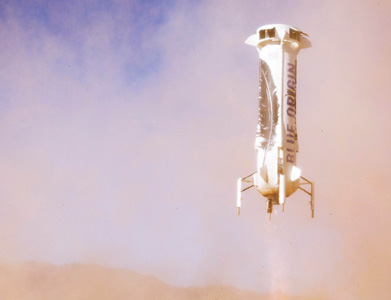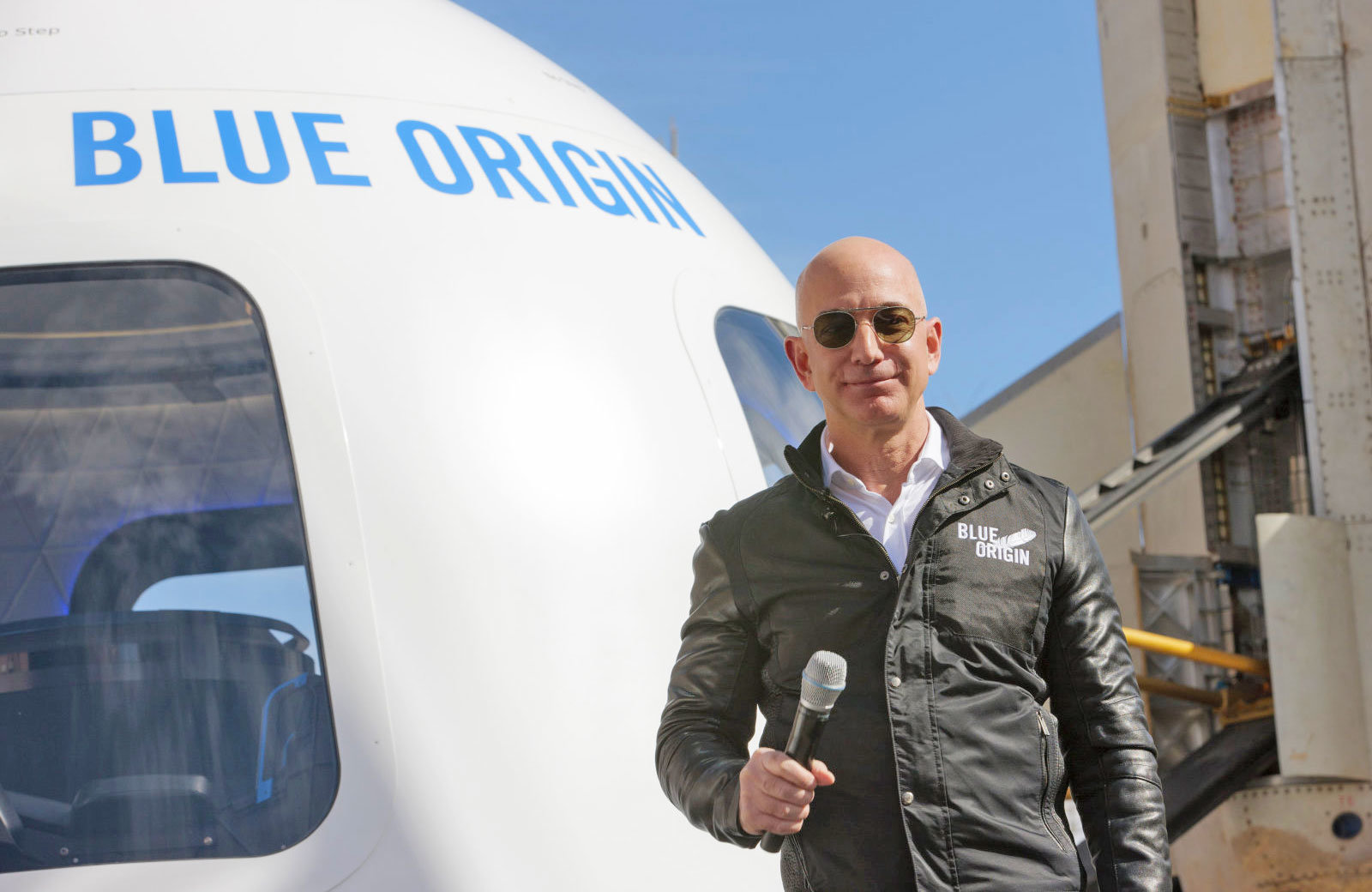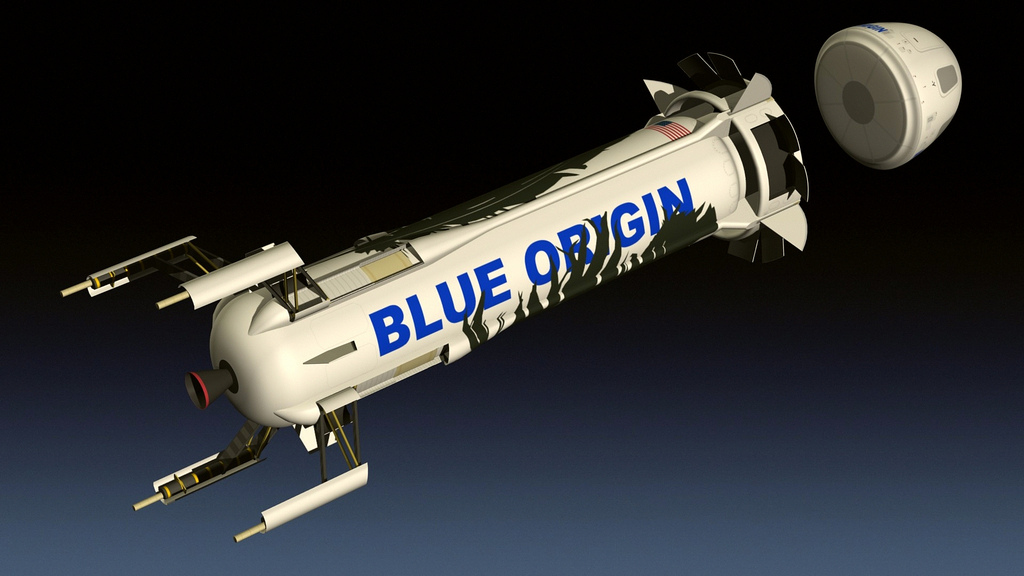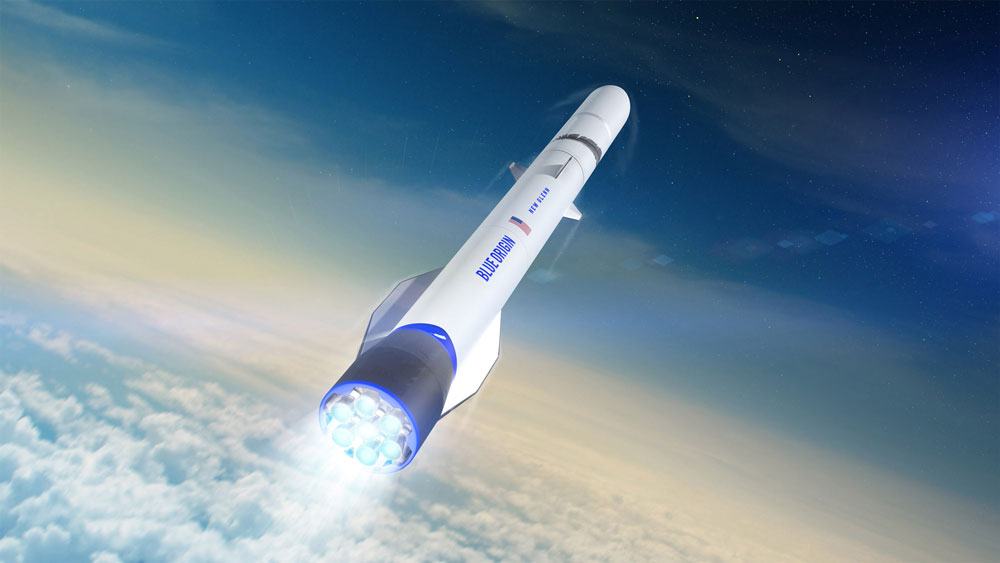Blue Origin
Each of the big three commercial companies trying to put people into space has a world famous businessman at the helm. Like a benevolent Bond villain, they plot and scheme, ploughing billions of dollars into their plans. Many a fictional Bond nemesis has tried and failed to conquer space: Hugo Drax stole a Space Shuttle but was foiled by Roger Moore in Moonraker.
Of course, before m’ learned friends reach for their writs, our trio of ambitious business magnates are proposing to use only legal means to put their passengers into space. They plan world domination only by legal and totally benign means – via the potentially lucrative business of space tourism. And for Blue Origin, the man at the top is Jeff Bezos.
Some Background To Space Origin
Bezos is renowned as the founder and chief executive of Amazon, the online shopping and logistics service. Amazon is already a worldwide phenomenon, dominating online sales in a large proportion of the western world and beyond. Now publicly listed, Bezos continues to hold a large stake in the company, estimated to be around 15%.
The figures behind this global success story are truly eye watering. At the end of 2017, the last year for which figures are available, Amazon posted total revenues of close to $180 billion. Its net income, after all costs, expenses and taxes are paid, was over $3 billion. At the time of writing, this makes it the third largest company in the United States, behind Apple and Microsoft. It is responsible for the direct employment of over 500,000 people across the globe. Bezos’s own personal worth is estimated to be around $125 billion.
The financial performance and continued prosperity of Amazon is crucial to Bezos because it provides the funding to enable him to invest in his new space technology ambitions. Spending on his Blue Origin project has in recent times has been acknowledged to be at least $1 billion per year, with the vast majority of funding derived from the sale of Bezos’s Amazon shares.
The company is headquartered in Kent in the western US state of Washington. It has rocket launch facilities in both Texas and Florida.

The History Behind Blue Origin
Blue Origin was founded back in 2000, and in the early days was entirely privately funded by Bezos himself. Its existence did not become public knowledge until several years later, in 2003. It was at this point that journalists became aware of some large and unexplained land purchases in the US state of Texas. Since these purchases were far in excess of what was necessary for even an Amazon sized warehouse, questions began to be asked. The company’s primary goal was and remains to provide an affordable way to put people into space.
Bezos devised two main strategies which remain fundamental to the Blue Origin mission. The costs of rocket technology and space travel are astronomical (to coin a phrase), as we can see from the above figures. So Bezos resolved that the company would attempt to keep spending under control by designing reusable technology wherever possible.
Secondly, the company was to use an incremental approach, gradually enhancing its technology and performance, learning from improvements at every stage along the way. Indeed, the company’s Latin motto can be translated as “step by step, ferociously”. Critics and pundits sometimes criticise Blue Origin for its slow pace of development. Bezos may well point them in the direction of the fable of the Tortoise and the Hare.
When compared to his publicity hungry rivals, the Bezos also does things more quietly. His big name competitors engage in regular publicity stunts, including newsworthy public appearances, launch fanfares and even, in the most spectacular example, launch a car into space. Blue Origin on the other hand, reflecting its quieter, more private owner, just gets on with the job. So while his rival companies have countless more watches on YouTube and millions more followers on Facebook and Twitter, Bezos’s own efforts sometimes fly under the radar as far as publicity is concerned.

Throughout the year in development, Blue Origin has focused entirely on conventional rocket style launches, avoiding the additional complications of the aircraft aided approach preferred by its British rival. Starting with some sub-orbital launches, it has gradually improved the power and carrying capacity of its rocket technology. At the time of writing it has achieved a maximum height of well over 100 km with its unmanned passenger carrying vehicle, reaching a top speed of over three times the speed of sound (Mach 3).
Importantly though, in keeping with its recycling ethos, both the passenger capsule and launch rocket are returned safely back to Earth for future re-use. Manned test flights are planned soon, with the first commercial passenger launch being slated around a year later.
In the meantime, the company has continued to abide by its gradual approach to development by signing a co-operation deal with US state funded NASA under its Space Opportunities programme. By 2018, it was already carrying commercial and experimental payloads into space on its New Shepard rockets.
The Development
The story of the development of the company’s rocket technology has certainly fulfilled its gradual, incremental ethos. Its first test flight came in early 2007, with a low altitude mission. But it took almost a decade of research, development and partnership agreements for the company to take its first real step toward its goal of reaching space.
New Shepard
This first real step came in 2015 with the first developmental mission of its New Shepard rocket. Named after the pioneering NASA astronaut Alan Shepard, this fully re-usable, passenger carrying vehicle comes in two sections. The rocket booster stands at the base, with the passenger capsule placed on top. The spaceship is shorter and squatter than most comparable rockets, which aids with the stability required both in flight, and to successfully land back on Earth. The rocket will take off and land vertically (VTVL).
New Shepard is designed to be sub-orbital, enabling its payload of six potential passengers to reach the 100 km margin of space and beyond. Its paying astronauts will then enjoy a period of weightlessness and a wonderful view of the blue planet and the blackness of space before returning to Earth. There are no pilots or flight crew, as New Shepard launches are designed to be entirely automated.
By the end of 2015, the engines powering the rocket had been tested over a hundred times. Progress was remarkable. So much so that by November a real milestone in the development of the spacecraft was achieved. This was when the rocket was landed safely back on Earth for the very first time, enabling its successful re-use for a future launch.
2016 saw repeated test flight, all the time gathering data and making gradual, incremental improvements, as promised. With a view to the eventual purpose of these flights, the ferrying of private passengers into space, a further essential improvement was introduced. The autumn saw the successful testing of an escape mechanism, enabling the capsule to be separated from the rocket booster at any stage of the flight, should an emergency occur or the need arise.
The latest design of the passenger capsule was launched in 2017, while December that year saw the rocket carrying its first commercial payload. This too, was a momentous event, offering the potential of beginning to recoup some of the massive investment already made in the project.
The year 2018 saw the company reach ever closer to its final goal of putting people into space. It was then that the unmanned capsule was launched to its highest ever point at that time of over 100km (over 310,000 feet). A commercial agreement was also signed with the US Air Force to launch its payloads.
The new rocket also received the approval of NASA, the US state funded space organisation. This came with the agreement to fly nine NASA sponsored experimental payloads into space. These were successfully launched on the 10th New Shepard mission in December.

New Glenn
But even this remarkable progress only tells part of the story. In tandem with the development of a passenger carrying spacecraft, Blue Origin is also designing a bigger, more powerful rocket. Whilst New Sheppard was designed for sub-orbital flight only, this new rocket is intended to carry commercial payloads such as satellites to greater altitudes, either at low Earth orbit, or even into the much higher geo-stationary orbits required for navigation and observational satellites.
Named after another legendary NASA astronaut John Glenn, design began in 2012. This rocket is a much bigger affair. Designed to carry much heavier payloads, it comes in two stages, only the first of which is re-usable. This first stage will be designed to be recycled at least 25 times, keeping launch costs to a minimum. Commercial, civil and state payloads will be carried, with several agreements already signed with companies across the world.
This rocket will truly be a monster, with a carrying capacity twice that of any of its many competitors. It will be the biggest rocket in terms of both size and potential payload since the legendary Saturn V – the largest ever built to date, which launched the Apollo astronauts on the way to the Moon.
This means that New Glenn also has the potential to carry astronauts and cosmonauts to the International Space Station (ISS). It could eventually replace the ageing Soviet Union era Soyuz spacecraft, an old workhorse featuring 1960s technology which is currently the only means of transporting crew to the ISS. The first launch of this new rocket is expected in 2021, from Blue Origin’s launch pad on the Florida Space Coast.

The Future for Blue Origin
No one could possibly accuse Bezos of a lack of vision or ambition. For us, the development of any kind of space tourism service seems a remarkable achievement. But Bezos is already thinking ahead. For him, this will be just the start. The next goal is to enable people to live in space and ultimately, the human colonisation of the cosmos.
As a step toward this, the company is developing a lunar lander, capable of transporting massive and heavy payloads to the Moon. This is currently timetabled for 2023 and after that… some real lunar colonies. Now this really is sounding a bit more like something from a Bond movie…
In the meantime, the race to be the first to launch paying passengers into space is hotting up. All three of the main players are getting ever closer to their goal. With Jeff Bezos’s billions behind it, some space pundits are favouring the Amazon magnate to be the first. Sometimes the quiet ones are the ones to watch.
Maybe Bezos is hedging his bets though. His New Glenn design is looking to a future partnership with NASA and other, more commercial organisations to provide a long term future, and a valuable source of additional funding for his company. Either way, the future is bright for Blue Origin. First Earth orbit, then the Moon, and onward to the stars…
